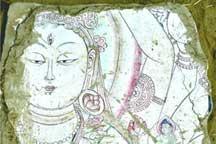CCTV, 15-2-2013
Watch Video

 Play Video
Play Video
Our reporter Wu Lei, has just set off with a group of experts on an excavation trip into the Taklamakan desert. Let’s cross over to him for more details.
Hello, Wu Lei. Thanks for joining us. What are the experts hoping to find during this trip?
Could you please introduce us to the team of experts you’re following?
CCTV, 15-2-2013
Watch Video

 Play Video
Play Video
By CCTV reporter Wu Lei
Among all the places bordering the Taklamakan desert, Damagou township has found the largest quantity of ancient Buddhist relics and the best preserved ones. But it is the vast desert that has proven challenging for the local relics protection department.
Heading north of Damagou township, we came to the southern edge of the Taklamakan desert. There is no fixed road, only a rough pass between sand dunes.
Nearly all the Buddhist relics and historical ruins in the Damagou area were covered by the desert and huge bushes of rose willows. This willow bush looks like any other, but a great number of Buddhist murals were found beneath it. It was named Abas Ruins.
 |
| Among all the places bordering the Taklamakan desert, Damagou township has found the largest quantity of ancient Buddhist relics and the best preserved ones. |
A few years ago, a local man named Abas found some relics under this ruin when he was searching for dried rose willows. But unfortunately, illegal treasure hunters came earlier than the archeologists.
Many murals and relics were stolen and damaged. Since then, the local relics protection department began to hire more locals to inspect the ruins. 41 year old Abudu Kadier is one of the five inspectors. He and his colleagues need to check the sand dunes and willow bushes everyday. And he finds some newly exposed murals every once in a while.
Abudu Kadier, Relics Inspector of Cultural Relic Protection Dept., Cele County, said, "When we find relics, we need to inform our department immediately. After our colleagues come, we continue inspections and update the department on the situation here everyday."
 |
| Many murals and relics were stolen and damaged. Since then, the local relics protection department began to hire more locals to inspect the ruins. |
Abas ruin is only one of the current 20 ruins in the whole area. Yet, there are still many secrets covered by the desert.
Lu Shehui, Secretary of Cultural Relic Protection Dept., Cele County, said, "It is possible to find this kind of buddhist mural beneath every sand dune. Because the wind or local villagers can remove the sand unexpectedly, the mural appears from time to time."
The sand in the Taklamakan desert moves very quickly with the wind. The most recent found murals were exposed probably due to days of blowing wind. According to procedure, they need to rebury the murals with sands for further protection.
 |
| Among all the places bordering the Taklamakan desert, Damagou township has found the largest quantity of ancient Buddhist relics and the best preserved ones. |
Lu Shehui, said, We used to inspect all the relic ruins by walking or riding camels, but now the conditions are better and we have equiped all the inspectors with motorcycles.
Because of the increasing number of thefts and illegal excavations in the last 3 years, the local relics protection department has increased inspectors’ salaries to 1000 yuan per month, and given a motorcycle to each one.
This has been a huge effort for a poverty-stricken county. But for the almost 200 relic sites in the Damagou area, there are only 5 inspectors in total. It is far from enough to fully protect the ancient treasures. Wu Lei, CCTV, Damagou Township, Xinjiang Uygur Autonoums Region.
 |
| Many murals and relics were stolen and damaged. Since then, the local relics protection department began to hire more locals to inspect the ruins. |
No comments:
Post a Comment